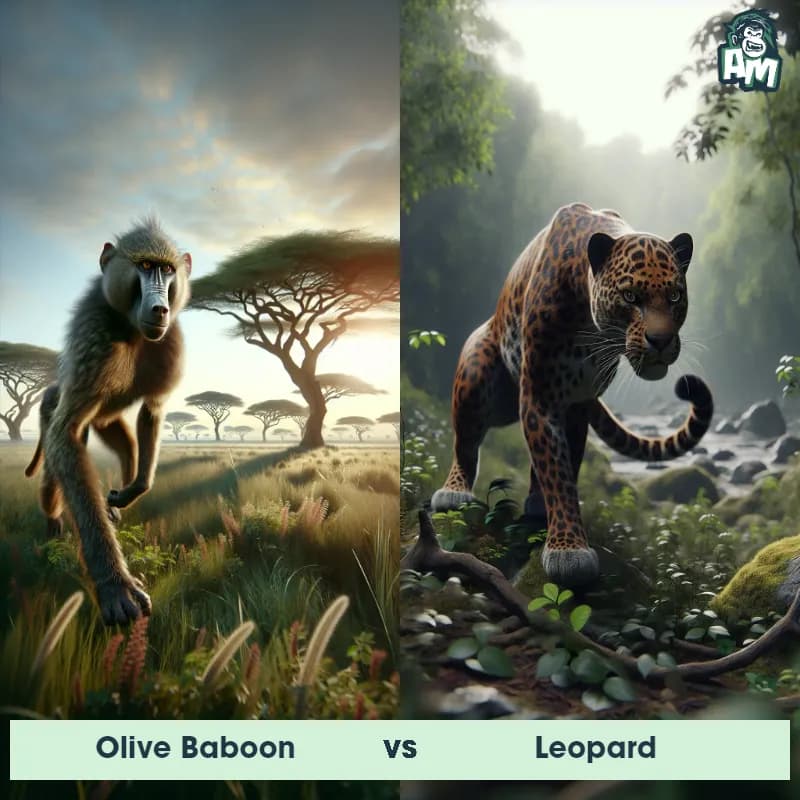Olive Baboon vs LeopardSee Who Wins

Welcome to the showdown between the Olive Baboon and Leopard! These two fierce competitors are ready to go head to head in a battle of strength and agility. Let's see who comes out on top in this epic matchup.
Contender 1: Olive Baboon
The Olive Baboon, also known as the Anubis Baboon, is a species of baboon native to parts of East Africa and the Arabian Peninsula. These social primates are easily recognized by their large size, with males typically weighing around 30-40 kilograms and females being slightly smaller. Olive Baboons have short, coarse fur that ranges in color from yellowish-brown to gray, and their faces are hairless with prominent muzzles. They possess long, powerful limbs with grasping hands and opposable thumbs, making them adept climbers and walkers. With their impressive canines and protruding face bones called ischnia, they exhibit a robust appearance. These baboons are known for living in large groups called troops, which can contain up to 150 individuals, and engaging in complex social interactions.
Fun Fact: One fascinating fact about Olive Baboons is that they have a diverse diet, which includes a wide range of fruits, leaves, seeds, insects, small vertebrates, as well as occasional carrion and even soil, making them opportunistic omnivores.
Contender 2: Leopard
The Leopard is a large and powerful carnivorous mammal that is known for its distinctive coat pattern consisting of rosette-like spots. It has a slender body, muscular limbs, and a long tail, enabling it to be agile and swift. Leopards are primarily nocturnal creatures, preferring to hunt during the cover of darkness. They are highly adaptable and can thrive in a variety of habitats, ranging from dense forests to open grasslands. With exceptional climbing skills, they are capable of dragging their prey up trees to keep it safe from other predators.
Fun Fact: Leopards are incredibly strong and possess immense agility, as they are capable of leaping horizontally up to 6 meters and vertically up to 3 meters, allowing them to ambush their prey from above with precision.
Matchup Stats
| Olive Baboon | Leopard | |
|---|---|---|
| Size | 2-3 feet (60-90 cm) tall | 24-28 inches (60-71 cm) at the shoulder; 5-6 feet (1.5-1.8 meters) in length |
| Weight | 66-88 pounds (30-40 kg) | 80-160 pounds (36-73 kilograms) |
| Speed | 34mph (55km/h) | 36-37mph (58-60km/h) |
| Key Strength | Powerful jaws and canines | Powerful jaw and sharp claws |
| Biggest Weakness | Vulnerable to attacks on their lower body | Less endurance compared to some other big cats |
Current Votes
Olive Baboon vs Leopard
See Who Wins
View More Matches
Looking For More?
Similar Matches
Scientific Stats
| Olive Baboon | Leopard | |
|---|---|---|
| Scientific Name | Papio anubis | Panthera pardus |
| Family | Cercopithecidae | Felidae |
| Habitat | Forests, savannas, and woodland areas | Variety of habitats including forests, grasslands, and mountains |
| Geography | East Africa and the Arabian Peninsula | Africa, parts of Asia |
| Diet | Fruits, leaves, seeds, insects, small vertebrates, carrion, and soil | Carnivorous, preys on various animals including ungulates, small mammals, birds, and reptiles |
| Lifespan | 20 years - 30 years | 12 years - 17 years |
Key Differences between Olive Baboon and Leopard
- Facial features: The Leopard has a rounder face with prominent whisker spots, sharp teeth, and piercing eyes, while the Olive Baboon has a longer snout, flatter face, and distinctively shaped nose.
- Color: The Leopard typically has a spotted coat with a golden-yellow background, while the Olive Baboon has a grayish-brown coat with a more uniform coloration.
- Body shape: The Leopard has a more sleek and agile build, with a longer body and shorter limbs, compared to the Olive Baboon which has a stockier appearance.
- Size: The Leopard is generally larger and heavier than the Olive Baboon.
- Tail: The Leopard has a long, thick tail that is often used for balance and camouflage, while the Olive Baboon has a shorter, thinner tail that is not as prominently displayed.
- Markings: The Leopard has distinctive rosette patterns on its fur, while the Olive Baboon lacks any prominent markings.
































